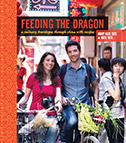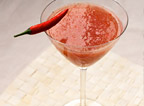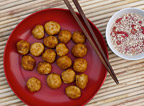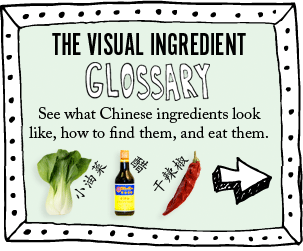
Right now I'm reading Snow Flower and the Secret Fan, a beautiful novel by Lisa See. It's featured on Oprah's book club (which never hurts) and an international bestseller. The first few chapters follow the story of a 7 year old girl in the 1800s as she starts the Chinese footbinding process. The agony and details of which have been difficult for me to stomach. I had no idea that four toes were purposefully broken and folded back up under the foot and big toe. For the rest of the women's lives they could hardly balance to walk or even stand. They spent most of their lives sitting in a "women's room" because they couldn't do much else. During the four hundred or so years that women practiced footbinding in China, the ideal "beautiful" foot was 6 centimeters in length. I've never been so thankful for my big feet.
Anyway! There's a part where the narrator, Lily, then just a little girl, eats her first sugary dessert. "Have you had sugar, Lily?" her friend, Snow Flower, asks. "It is the best thing in the world."
Snow Flower goes on to talk about how Old Man Zuo makes "the best treat in the country" at his stand. Of course I wanted to eat this dessert that Snow Flower calls the best in the world. She goes into detail about how Old Man Zuo makes Fried Taro dessert and I thought I would follow the directions from the book's passage as closely as possible and see what I could come up with. Here's the passage:
"Here's what he does: He fries cubes of taro until they are soft on the inside but firm and crisp on the outside. Then he melts sugar in a big wok over a large fire... He melts it until it turns brown, then he throws the fried taro into the sugar and swirls it around until it is coated. He drops this on a plate and places it on your table, along with a bowl of cold water. You can't believe how hot the taro is with that melted sugar. It would burn a hole in your mouth if you tried to eat it like that, so you pick up a piece with your chopsticks and dip it in the water. Crack, crack, crack! That's the sound it makes as the sugar goes hard. When you bite into it, you get the crunch of the sugar shell, the crispiness of the fried taro, and then the final soft center."
My findings and subsequent Fried Taro dessert recipe:
I got taro (a potato-like root) at a market in Chinatown. An Asian food market is probably your best bet for finding taro. For tips on selecting taro, read this taro post.
As soon as I read this passage I thought fried taro dessert sounded a lot like a northern Chinese dish Nate often makes called Fried Candied Apples. He fries apple wedges with a flour-based batter coated on the outside, then dips them in hot caramelized sugar. They are so hot when they come out, you have to dip them in cold water before eating. This apple dessert is all over China. It's yummy and kind of fun to make and eat. I thought that this Fried Taro dessert might benefit from adding a batter (no offense to Old Man Zuo). I was wrong. I fried it with and without and without is better. Something about adding a batter to the starchy taro felt heavy. It's kind of like fried oreos -- why? -- oreos were doing just fine before people started frying them.
Note: The picture above is of the battered taro version. If you cook our recipe below, yours will look slightly different without the batter coating.
Fried Taro Dessert
1 lbs. taro, peeled and cubed about 1/2 inches
oil for deep-frying
1/2 cup sugar
1 tsp. sesame oil
1 tbs. lard or shortening
Soak taro cubes in a bowl of ice water for 15 minutes (necessary to get the starch out). Drain the taro and pat dry. Heat 2 inches of the oil in a wok over high heat until it is very hot. Add about 10 taro cubes to the oil and fry for 2-3 minutes or until golden brown. Remove the cubes with a strainer and place on paper towels to drain. Fry the remaining taro cubes in this way.
Discard the oil from the wok and put in the sugar, sesame oil, and shortening. Stir the sugar continuously for about 2 minutes or until the sugar caramelizes and turns a light brown then remove the wok from the heat. Use chopsticks to dip each fried taro cube in the caramelized sugar. Place the coated taro cubes on a plate and serve with a small bowl of ice water. Before eating, instruct your guests to use their chopsticks to dunk the taro in the ice water so that the sugar hardens and cools before eating.
-mary kate

 8 Comments | |
8 Comments | |  Permalink
Permalink 










